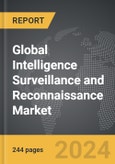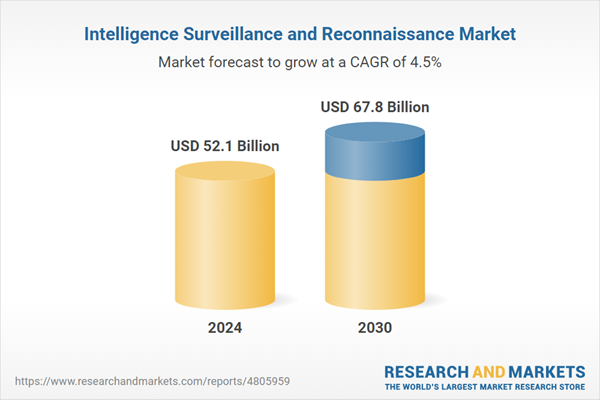Global Intelligence, Surveillance, and Reconnaissance (ISR) Market - Key Trends & Drivers Summarized
What Is Intelligence, Surveillance, and Reconnaissance (ISR) and Why Is It Vital for National Security?
Intelligence, surveillance, and reconnaissance (ISR) refers to the collection, processing, and dissemination of information to support military operations and national security. ISR is vital for national security as it provides critical insights into potential threats, enabling decision-makers to respond effectively and protect national interests. ISR encompasses a wide range of activities, including the use of satellites, unmanned aerial vehicles (UAVs), radar systems, and other sensors to gather intelligence on enemy movements, infrastructure, and capabilities. The information collected through ISR is used to inform strategic decisions, support military operations, and enhance situational awareness. As global security threats continue to evolve, the role of ISR in providing timely and accurate intelligence is becoming increasingly important, making it a critical component of modern defense strategies.How Are Technological Advancements Shaping the ISR Market?
Technological advancements are significantly shaping the ISR market, particularly through the development of more advanced sensors, data analytics, and autonomous systems. The use of AI and machine learning in ISR is enabling the analysis of vast amounts of data collected from various sources, allowing for more accurate and timely intelligence. The development of advanced sensor technologies, including hyperspectral imaging and synthetic aperture radar (SAR), is enhancing the ability to detect and identify targets in a wide range of environments, including those with challenging weather conditions or dense vegetation. The rise of autonomous systems, such as UAVs and unmanned ground vehicles (UGVs), is also transforming the ISR landscape by providing more flexible and cost-effective means of gathering intelligence. Additionally, advancements in satellite technology are improving the resolution and coverage of ISR systems, enabling more comprehensive monitoring of global hotspots. These technological innovations are driving the development of more sophisticated and capable ISR systems, which are increasingly being adopted by military and intelligence agencies around the world.Why Is There an Increasing Demand for ISR Capabilities Across the Globe?
The demand for ISR capabilities is increasing across the globe due to the growing complexity of global security threats and the need for enhanced situational awareness. In the face of rising geopolitical tensions and asymmetric warfare, military forces and intelligence agencies are relying more heavily on ISR to gather actionable intelligence and support decision-making. The proliferation of advanced weapons systems and the increasing use of unconventional tactics by state and non-state actors are also driving the need for more sophisticated ISR capabilities that can detect and neutralize emerging threats. The expansion of global military operations, particularly in regions with limited infrastructure and challenging environments, is further contributing to the demand for ISR systems that can provide real-time intelligence in remote and hostile areas. Additionally, the rise of cyber warfare and the need to monitor and protect critical infrastructure are leading to increased investment in ISR capabilities that can provide comprehensive coverage of both physical and digital domains. As global security challenges continue to evolve, the demand for ISR systems that can provide timely and accurate intelligence is expected to grow.What Factors Are Driving the Growth in the ISR Market?
The growth in the ISR market is driven by several key factors that reflect the evolving nature of global security threats and the increasing reliance on advanced technologies for intelligence gathering. One of the primary drivers is the rising demand for real-time intelligence in military operations, as decision-makers seek to respond more quickly and effectively to emerging threats. The increasing complexity of global security challenges, including the rise of asymmetric warfare and the proliferation of advanced weapons systems, is also driving the need for more sophisticated ISR capabilities. Another significant factor is the growing emphasis on multi-domain operations, where military forces need to integrate intelligence from land, sea, air, space, and cyberspace to gain a comprehensive understanding of the operational environment. The rapid development of AI, machine learning, and autonomous systems is further fueling the growth of the ISR market, as these technologies enable more efficient and effective intelligence gathering and analysis. Additionally, the increasing investment in defense and security by governments around the world is supporting the expansion of ISR capabilities, particularly in regions with growing security concerns. These factors, combined with ongoing advancements in ISR technologies, are expected to drive continued growth in the global ISR market.Report Scope
The report analyzes the Intelligence Surveillance and Reconnaissance market, presented in terms of units. The analysis covers the key segments and geographic regions outlined below.Segments: Platform (Land, Air, Sea, Space).
Geographic Regions/Countries: World; United States; Canada; Japan; China; Europe (France; Germany; Italy; United Kingdom; and Rest of Europe); Asia-Pacific; Rest of World.
Key Insights:
- Market Growth: Understand the significant growth trajectory of the Land segment, which is expected to reach US$23.5 Billion by 2030 with a CAGR of a 4.2%. The Air segment is also set to grow at 5.2% CAGR over the analysis period.
- Regional Analysis: Gain insights into the U.S. market, valued at $14.2 Billion in 2024, and China, forecasted to grow at an impressive 4.2% CAGR to reach $10.7 Billion by 2030. Discover growth trends in other key regions, including Japan, Canada, Germany, and the Asia-Pacific.
Why You Should Buy This Report:
- Detailed Market Analysis: Access a thorough analysis of the Global Intelligence Surveillance and Reconnaissance Market, covering all major geographic regions and market segments.
- Competitive Insights: Get an overview of the competitive landscape, including the market presence of major players across different geographies.
- Future Trends and Drivers: Understand the key trends and drivers shaping the future of the Global Intelligence Surveillance and Reconnaissance Market.
- Actionable Insights: Benefit from actionable insights that can help you identify new revenue opportunities and make strategic business decisions.
Key Questions Answered:
- How is the Global Intelligence Surveillance and Reconnaissance Market expected to evolve by 2030?
- What are the main drivers and restraints affecting the market?
- Which market segments will grow the most over the forecast period?
- How will market shares for different regions and segments change by 2030?
- Who are the leading players in the market, and what are their prospects?
Report Features:
- Comprehensive Market Data: Independent analysis of annual sales and market forecasts in US$ Million from 2024 to 2030.
- In-Depth Regional Analysis: Detailed insights into key markets, including the U.S., China, Japan, Canada, Europe, Asia-Pacific, Latin America, Middle East, and Africa.
- Company Profiles: Coverage of players such as BAE Systems PLC, Boeing Company, The, CACI International, Inc., Elbit Systems Ltd., General Dynamics Corporation and more.
- Complimentary Updates: Receive free report updates for one year to keep you informed of the latest market developments.
Some of the 41 companies featured in this Intelligence Surveillance and Reconnaissance market report include:
- BAE Systems PLC
- Boeing Company, The
- CACI International, Inc.
- Elbit Systems Ltd.
- General Dynamics Corporation
- Harris Corporation
- Kratos Defense & Security Solutions, Inc.
- L3 Technologies, Inc.
- Lockheed Martin Corporation
- Northrop Grumman Corporation
- Thales Raytheon Systems
- The Rheinmetall Group - Defence Sector
Tariff Impact Analysis: Key Insights for 2025
Global tariff negotiations across 180+ countries are reshaping supply chains, costs, and competitiveness. This report reflects the latest developments as of April 2025 and incorporates forward-looking insights into the market outlook.The analysts continuously track trade developments worldwide, drawing insights from leading global economists and over 200 industry and policy institutions, including think tanks, trade organizations, and national economic advisory bodies. This intelligence is integrated into forecasting models to provide timely, data-driven analysis of emerging risks and opportunities.
What’s Included in This Edition:
- Tariff-adjusted market forecasts by region and segment
- Analysis of cost and supply chain implications by sourcing and trade exposure
- Strategic insights into geographic shifts
Buyers receive a free July 2025 update with:
- Finalized tariff impacts and new trade agreement effects
- Updated projections reflecting global sourcing and cost shifts
- Expanded country-specific coverage across the industry
Table of Contents
Companies Mentioned (Partial List)
A selection of companies mentioned in this report includes, but is not limited to:
- BAE Systems PLC
- Boeing Company, The
- CACI International, Inc.
- Elbit Systems Ltd.
- General Dynamics Corporation
- Harris Corporation
- Kratos Defense & Security Solutions, Inc.
- L3 Technologies, Inc.
- Lockheed Martin Corporation
- Northrop Grumman Corporation
- Thales Raytheon Systems
- The Rheinmetall Group - Defence Sector
Table Information
| Report Attribute | Details |
|---|---|
| No. of Pages | 244 |
| Published | April 2025 |
| Forecast Period | 2024 - 2030 |
| Estimated Market Value ( USD | $ 52.1 Billion |
| Forecasted Market Value ( USD | $ 67.8 Billion |
| Compound Annual Growth Rate | 4.5% |
| Regions Covered | Global |









